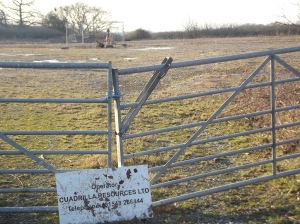Last week I attended SMi’s timely Shale Gas Environmental Summit in London. Timely because the UK government is now sending clear messages that there is too much hot air spouted about shale gas and believes it will not be a game-changer as in the United States.
Here are my top ten ‘takeaways’ from the summit, some positive, some negative.
1. There is a great deal more shale gas than current official estimates state.
The Environment Agency’s head of climate change and sustainable development Tony Grayling said the Department of Energy and Climate Change (DECC) and the British Geological Survey’s (BGS) joint report on unconventional hydrocarbons – expected to be released by DECC around the turn of the year – will show that UK shale gas reserves estimates will be “nearer to Cuadrilla’s estimate of 6,000 billion cubic metres (BCM)” than previous estimates of 150 BCM.
A quick note is needed here. DECC/BGS’ 2010 estimate showed potential UK shale gas recoverable reserves of 150 BCM. By comparison, annual UK consumption is 90 BCM.
Cuadrilla’s estimate of 6,000 BCM is just for its exploration area in Lancashire – about 500 square miles – not the whole of the UK. Furthermore, Cuadrilla’s estimate is for total ‘gas in place’ in the shale, not recoverable reserves.
Grayling said: “The new estimate will be volumetric rather than area-based and we can certainly expect their estimate to be a lot higher”.
2. A seismic activity limit of 0.5 magnitude ought not to be a show-stopper.
In April, an independent report published by DECC recommended fracking should be immediately halted if seismic activity is recorded of a magnitude of 0.5 or above, far below Cuadrilla Resources’ proposed level of 1.7.
The EA’s Tony Grayling said a 0.5 limit was practicable. “The reason why the DECC report set the seismic limit at 0.5 magnitude far lower than the 1.7 is because there is a time delay between the fracking process and larger tremors. Unless you stop them at a lower level you risk a larger tremor later.”
The seismicity report is out for consultation and a response from DECC is expected in July. In the meantime, fracking is suspended in the UK.
3. The risk to groundwater is from surface drilling, not horizontal fracking
The main risks to groundwater contamination are on the surface, relating to construction and operation of shale gas drilling wells, says Grayling. “The surface must be lined,” he said. “We don’t think the risks are from the fracking process itself, as this occurs 2-3 km below the surface.”
Evidence from the US suggests that as long as the well is properly constructed, the fractures do not provide a route for pollutants – at least in the geology of Lancashire – to enter into groundwater. Grayling added: “Using micro-seismic monitoring of the propagation of fractures through the shales we will have empirical evidence to confirm US evidence that they don’t propagate beyond the shale field [and into aquifers].”
Grayling notes that the Bowland shale is a saline aquifer and is not suitable for drinking water.
4. Current national and EU regulations are adequate for shale gas exploration but inadequate for shale gas production
Grayling said: “Current regulation is adequate for small-scale exploration but we are keeping that under review. We don’t yet know whether we have everything we need for exploration. We probably do not have all the information we need to effectively deploy our regulatory powers in all the circumstances that may arise from future circumstances.
“We are undertaking more detailed environmental assessment work this financial year with DECC, DEFRA and HSE.”
5. Shale gas is a PR disaster, says WPP firm
Simon Whitehead, managing director of Hill and Knowlton, an energy PR firm owned by Sir Martin Sorrell’s WPP, says there is “no love for shale gas” in the UK mostly due to the Gasland movie’s infamous flaming water taps scene.
In full business-pitch mode, Whitehead said: “There needs to be an industry-wide, offensive campaign with a fresh new narrative giving more of a brand feel to shale gas developments. Fracking needs a re-brand, perhaps with a ‘kitemark’ for safe developers.”
Whitehead also says Cuadrilla has made a mistake by probably over-estimating their potential shale gas resources. “Cuadrilla has over-egged the issue. Their claims about gas in place against recoverable reserves are still confused and people don’t really know the answer.”
6. Cuadrilla’s shale gas operations in Lancashire are more politically risky than Cairn Energy’s Arctic oil drilling in Greenland.
Rob Foulkes of Critical Resource, a quasi-ratings agency of socio-political risks for energy developments, rates Cuadrilla’s license to operate in Lancashire as a ‘B’, the same as Cairn Energy’s arctic oil drilling in Baffin Bay, Greenland.
The rating was based on site visits and interviews before Cuadrilla halted drilling last May due to seismic activity. This controversy, says Foulkes, may have notched the rating downwards.
External risks of shale gas such as seismic activity, water pollution, air pollution and visual impact, regulatory uncertainty, poor performance in the US, uncertainty of science, and polarized public opinion “have the capacity to substantially undermine Cuadrilla’s operations,” he said.
7. Fugitive methane emissions are estimated at 4%, which could make shale gas more environmentally damaging than coal, says UCL energy professor
Studies suggest fugitive emissions may total 4% of total gas captured from fracking, higher than conventional gas, says UCL’s Paul Ekins. “You only need fugitive emissions of 3-9% for gas to be equivalent to emissions from coal in power stations. Unless you can be very sure that these fugitive emissions won’t occur then the carbon benefits of substituting coal generation with gas might be seriously undermined.”
8. Flowback water is the “number one” pollution issue affecting shale gas, says gas lawyer
“If I had a chart of potential threats of pollution from shale gas, flowback water would be at the top of the list,” says gas markets lawyer Professor Alan Riley of City University Gray’s Inn. “One of the problems of the explosion of shale gas development in the US has been that the wastewater treatment plants haven’t been able to deal with the volume and the nature of the waste. This is a major problem if you want to drill hundreds of wells in the production stage.”
9. Even if gas prices drop 50%, shale gas is still no ‘gamechanger’, says Committee on Climate Change
David Kennedy, chief executive of the influential Committee on Climate Change, said its forthcoming annual report to Parliament contains a scenario where UK gas prices fall to US levels of around 35 pence per therm (compared to European levels of around 70p now).
“Even in this extreme case,” said Kennedy, “Shale gas is not a gamechanger. You’d still want to decarbonize the power sector in order to prevent higher energy bills in the long term. There is no economic rationale for a second dash for gas.”
10. The low calorific value of shale gas is a major issue, says gas guru
The average calorific value (CV) of the UK national gas grid is 39.5 megajoules per cubic metre; shale gas is quite low at around 37. To get round this, shale gas suppliers may have to inject propane, which costs 140p per therm, into gas transmission pipelines to make up for the shortfall.
“This is a major issue,” said John Baldwin, managing director of CNG Services Limited. “You probably will have to add propane in LTS (Local Transmission Systems).”
For injection into the National Transmission System (NTS), there would need to be “thousands of calorific value measurement devices all over the UK”, said Baldwin, in order to ensure accurate billing, as the lower CV of shale gas would mean end-users pay for gas priced at a higher CV than received.





Finally we are maybe seeing some sense. Do not start Fracking in the UK. It simply isn’t the price we should pay for more energy.
natural gas is not a renewable energy source.
As long as the earth exists, there will always be sun, wind, and geothermal heat. There will not always be fossil fuels, and the extraction of any such resources will always, always negatively impact human health and reduce the livability of our planet. I find it surprising that I have to explain the definition of renewable energy to anyone beyond sixth grade.
Posted by J.Daniels | June 26, 2012, 4:02 PMYou sound as if geothermal energy, wind and solar farm does have impacts on environment. Geothermal require pumping much much larger volume of pressurised water deep into hot rock and allow steam and hot liquid flow back up again, now how is that much different to fraccing. Once the geothermal rocks lose their heat, unless they are near volcanoes, we have to drill more holes.
Posted by Tommie | June 28, 2012, 1:52 AMWind turbine require rare earth mining which is one of the most polluted industries around (check out what they do in China, Malaysia and Mongolia). Solar panel production produce large amount of hexafluoroethane (C2F6), nitrogen trifluoride (NF3), and sulfur hexafluoride (SF6), that are use in solar cell fabricator. These are man-made green house gases that are 10,000 times (yes ten thousands) more potent than CO2. And all these wind and solar are not reliable or efficient enough to replace coal as baseload producer of electricity.
All source of energy has its drawback, including fossil fuel and natural gas, but natural gas is one of the less damaging source. By the way natural gas is ‘renewable’ in a sense because it is methane, a by-product of decomposing organic matters which are replenished by growing and dying organisms (algae, plants, animals, dead plants etc) that use sunlight and capture CO2 and fix them into their masses.